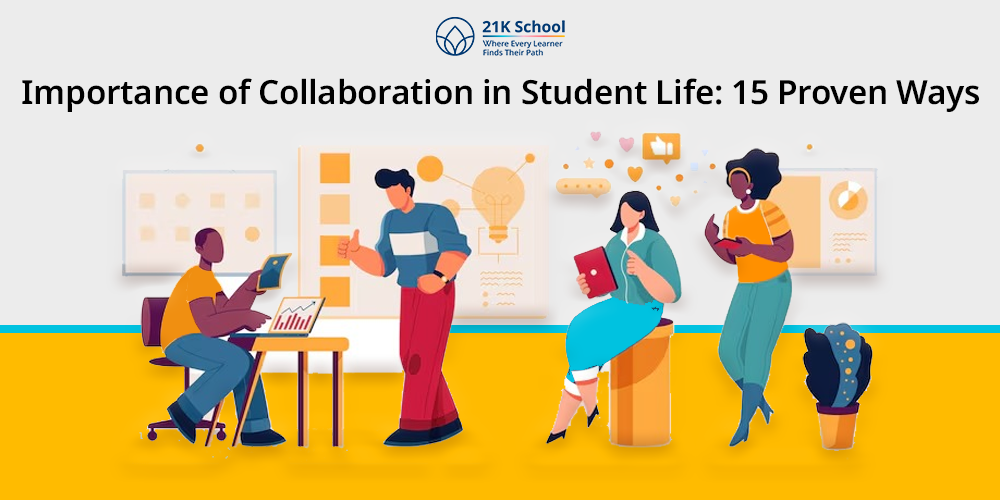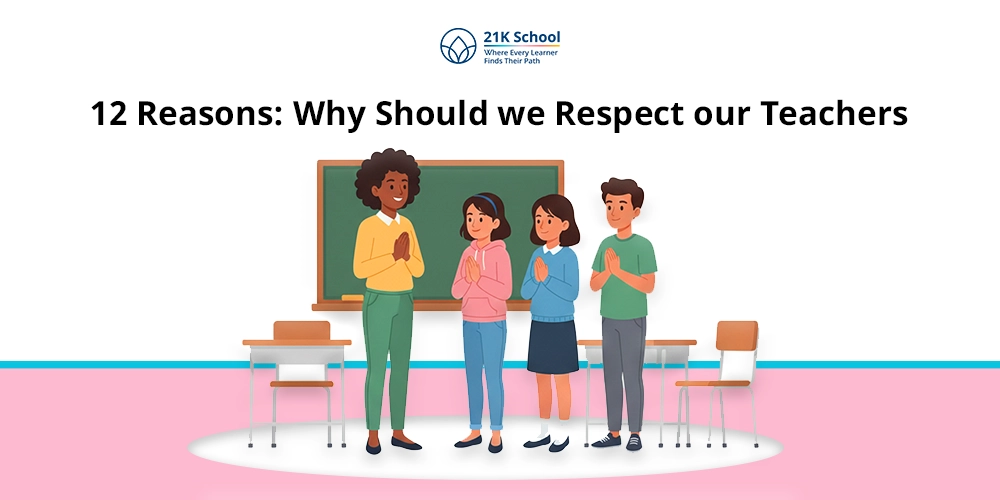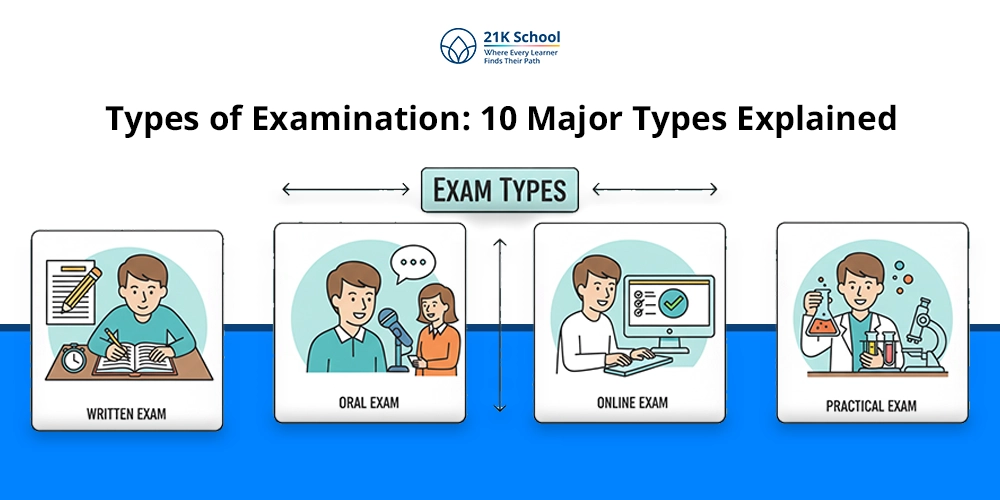
Education in the 21st century is no longer based on individual growth and achievement. Students are directed to work together as a team for better opportunities.
But the question is will this collaboration work well?
Collaboration doesn’t mean sitting together and learning, it includes sharing ideas, helping each other to resolve challenges and work towards a common goal.
It plays a major role where each student gets multiple chances to improve their learning as a group. Whether in a classroom setting or at home learners can engage in projects, extracurricular activities etc.
Let’s understand everything in detail from definition to importance of collaboration in students’ lives.
Table of Contents
- What is Collaboration?
- Importance of Collaboration in Students Life: Top 15 Ways
- 1. Deeper Engagement
- 2. Confidence Building
- 3. Enhance Problem-Solving Skills
- 4. Improved Critical Thinking
- 5. Developing Social Skills
- 6. Promotes Diversity
- 7. Build Trust
- 8. Builds Relationships
- 9. Effective Sharing
- 10. Fostering Social Interaction
- 11. Enhanced Communication Skills
- 12. Enhancing Learning Outcomes
- 13. Exposure to Diverse Perspectives
- 14. Preparation for the Real World
- 15. Quick Feedback
- Conclusion
What is Collaboration?
Collaboration is known as the procedure where students come together, share and fulfill common goals to achieve growth. These goals can be academic or personal.
The method is ideal for combining each other’s efforts, skill and knowledge to complete the project, homework or resolve a particular problem.
Remember, unlike competition, collaboration is guiding, supporting and managing each other’s work. The importance of collaboration includes focus on cooperation, collective effort, and mutual success.
Importance of Collaboration in Students Life: Top 15 Ways
The importance of collaboration in students’ life ensures social academic and professional development.
Mentioned 15 ways are ideal points to understand the importance of collaboration:
1. Deeper Engagement
Collaboration deepens student engagement especially in learning.
Learners work in a collaborative environment engaging in working together asking questions, sharing unique ideas, taking feedback and exploring different view points.
The process engaged them in active participation which directly leads to deeper understanding of concepts and student engagement.
2. Confidence Building
Confidence is a key to achieve success in life.
Group activities such as performing a task in competition or learning a difficult concept encourage each group member to step forward and share their opinions.
By this way a student who is shy or hesitant to answer gets an environment to improve his or her confidence level.
However, building confidence among students is not one day work so weekly or monthly collaboration is more beneficial.
3. Enhance Problem-Solving Skills
Students spend a lot of time stuck on a particular question or problem and sometimes feel shy or uncomfortable to ask facilitators multiple times.
Collaboration with peers ensures creative and easy solutions by connecting multiple minds together to resolve quickly.
By this way students develop problem solving skills and helping behaviour which build their personality. It is vital for academic development and future growth.
4. Improved Critical Thinking
Working as a team focuses on group discussions and debates in which students try to understand and evaluate each other’s points.
It lets them explore, ask questions, analyse, think assumptions and understand everyone’s viewpoints logically.
Collaboration improves critical thinking skills of learners by providing them with the right environment.
5. Developing Social Skills
Development of social skills in students is crucial to building and maintaining relationships.
Collaboration makes sure learners interact, argue, negotiate and resolve challenges together to build positive connections.
This will help them to gain knowledge more effectively in a positive learning environment. Social skills are not only ideal for building relationships but also social and emotional intelligence.
6. Promotes Diversity
In a collaborative environment learners not only share academic problems but also connect for diverse topics like each other’s backgrounds, cultures and experiences.
It will give them exposure to build better understanding about each other and ensure respect and empathy.
This way can build positive prospective respect for the different ways of living necessary to build a good personality in front of the world.
7. Build Trust
Trust is a base of both personal and professional life. Collaborative learning is one of the best methods through which students can build trust in each other.
By asking and giving help, guiding on difficult concepts, sharing responsibility and supporting in classroom learning.
Working in a team strengthens trust and confidence where each one feels included and contributes their best efforts. Must explore the benefits of collaborative learning in students’ lives.
8. Builds Relationships
Relationships become long-lasting when people give efforts and collaboration offers the opportunity to team up and connect each other.
Whether it’s sharing a project working on assignment exam preparation or revision meeting, it fosters relationships in both personal and academic ways.
A strong bond not only supports in difficult or challenging situations but also pushes for active participation and celebrates achievements.
9. Effective Sharing
As a student we always learn that sharing is caring. Collaboration gives an ideal environment to share knowledge, ideas and innovation or problems with each other without habitation.
By this way students learn the importance of collaboration in real life. Sharing can be done via small initiatives like asking or offering books, sharing classroom insights and knowledge sharing.
This builds a good habit which nurtures collaborative growth and development in children.
10. Fostering Social Interaction
School and playground are primary places where students connect and collaborate with each other. Here, build social interaction skills by taking part in sports, meetings and other extra curricular activities.
These collaborative tasks are very useful to build communication skills and interactions which reduces the feeling of loneliness and improves good relationships with peers.
11. Enhanced Communication Skills
A clear active and listening skills known as communication enhance through regular connecting and collaborating with other individuals.
Students in the classroom can discuss and present projects to improve their verbal and non-verbal communication skills.
Explore how technology impacts collaboration among students in group projects.
Remember, active participation and communication directly leads to growth, popularity and future global interactions.
12. Enhancing Learning Outcomes
Parents, teachers and even students always prioritise learning outcomes in the first place. And collaboration is one of the crucial parts.
Students teach each other, explain topics, clear doubts which help in sharing and retaining knowledge. This ensures a stronger and effective learning outcome.
13. Exposure to Diverse Perspectives
Sometimes classroom education and homeschooling limit students’ education up to course textbooks.
Collaboration offers exposure to diverse perspectives which help learners to understand their limitations. It further encourage open-mindedness, creativity, and tolerance.
14. Preparation for the Real World
Learning goes beyond knowledge and retention. It also needs practical application of information. Collaboration is an ideal way to implement real-life experiences.
Various techniques like Think-Pair-Share where learners think ideally, discuss in detail with peers and share in the classroom. The creative activities like group painting competitions, can be implemented to improve collaboration.
15. Quick Feedback
One of the importance of collaboration is, it offers quick feedback to learners. Students identify each other’s mistakes and help them to improve.
Immediate discussion and feedback faster learning and reduces confusions. The loop ensures continuous learning without distraction.
Conclusion
Collaboration is not limited to teaching methods, it carries various skills such as students engagement building relationship improving communication skills, problem solving skills etc.
Here, students also learn how to connect with new people, make them comfortable and resolve each other’s problems which helps them in personality development.
Collaboration can be implemented in a free period, outside activity or participation in school activities. However, the effective implementation of collaboration is based on careful structuring and planning. Not to miss here is that the results vary by subject or context based on the student’s needs.
The importance of collaboration is endless and in this interconnected world school, facilitators and parents play a major role to engage students in collaborative learning. It’s crucial to understand how to teach collaboration skills to students.
Remember, the earlier students embrace collaboration skills will get more opportunity academically, socially and professionally.



